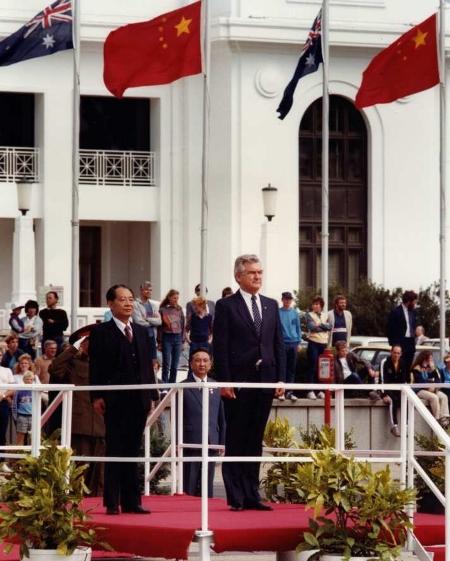The Hawke Government's China Policy
Bob Hawke was Prime Minister from 1983 to 1991. During that time he enjoyed a close personal relationship with the Chinese leadership and pioneered the integration of the Australian and Chinese iron and steel industries.
“An unusually close relationship”
On March 5 1983 Bob Hawke won the election and replaced Malcolm Fraser as Prime Minister.
On April 18 1983, less than one month after Mr Hawke came to power, Australia received Chinese Premier Zhao Ziyang, the first Chinese head of government to visit the country.[1]
In a welcoming toast to the Premier Prime Minister Hawke declared, “The policies of containment and isolationism of the 1950's and 1960's are no more than a bad memory”.[2]
On February 8 1984 Bob Hawke visited China for the first time as Prime Minister. Mr Hawke later wrote in his memoirs that he built an “unusually close relationship” with the Chinese leadership.[3]
On February 9 1984, following talks with Premier Zhao Ziyang, Prime Minister Hawke announced their agreement to integrate Australia and China’s iron and steel industries. In the Australia-China Relations Institute’s ‘China Correspondents Panel’ event former ABC correspondent Helene Chung, who was based in China at the time of this announcement, said “Everyone thought it was unbelievable. It would never work”.[4]
Following Prime Minister Hawke’s visit the two countries announced that Australia would establish a Consulate-General in Shanghai. The first conference for Chinese and Australian senior executives was held the following year in Beijing. This was the first step in strengthening business connections at a high level between the two countries.[5]
Between 1977 and 1984 two-way trade grew from $525.5 million to $1.2 billion reflecting an annual growth rate of 12.3 percent. During 1984-1985 Australia’s exports to China rose by 73.4 percent, exceeding $1 billion for the first time. In the space of one year China went from being Australia’s tenth largest export market to fifth.[6]
On April 13 1985 Australia received Chinese leaders for the second time under the Hawke Government with General Secretary Hu Yaobang and Secretariat member Hu Qili’s visit to Australia.
During this visit Prime Minister Hawke took General Secretary Yaobang to Mount Channar in the Pilbara which in 1990 was to become an iron ore mine, China’s first investment of this type.[7] Agreements were also signed to increase cooperation in the coal and wool industries, agricultural development and in non-ferrous metals and for Chinese consulates to be established in Melbourne and Perth.[8]
On May 19 1986 Prime Minister Hawke visited China for the second time during his leadership. It was on this trip that he met Deng Xiaoping for the first time.[9] The visit marked the fifth consecutive year that Chinese and Australian leaders visited each other’s countries.[10] When Mr Hawke visited in 1984 there was one joint venture between Australia and China. Two years later there were more than 16 joint ventures with a further 37 agreements under discussion. The Australian Prime Minister told Premier Zhao, “This generation has before it the real prospect of our region emerging for the first time in history as a place of prosperity for all of our peoples”.[11]
In 1986 Mr Hawke was awarded an honorary doctorate from Nanjing University, the first person to receive this honour.
An enduring legacy
In September 1986 the first Joint Ministerial Economic Commission was established. The annual commission provides the opportunity for ministers from both countries to discuss economic and trade cooperation and related scientific, technical and educational exchanges.
On November 13 1987 the Mount Channar Joint Venture was signed between China’s Ministry of Metallurgy and Hamersley Iron consolidating the earlier agreement between Mr Hawke and Hu Yaobang.[12]
On April 15 1989 General Secretary Hu Yaobang died of a heart attack. Protests in Tiananmen Square began soon after. Mr Hawke was planning another visit to China in October that year but the crackdown on June 4 “ruled that out”.[13]
On June 16 1989 Prime Minister Hawke announced he would grant 42,000 permanent visas to Chinese students in Australia. Many of those students are now Australian citizens, signalling the enduring impact of Prime Minister Hawke’s China policies.[14]
Endnotes
[1] Bob Hawke, 1983, ‘Speech by the Prime Minister at lunch in honour of Premier Zhao Ziyang’, Parliament House, Canberra, April 18 <http://pmtranscripts.dpmc.gov.au/browse.php?did=6089>.
[2] Ibid
[3] Bob Hawke, 1994, The Hawke Memoirs, William Heinemann, Melbourne p.342
[4] Helene Chung, 2015, ACRI correspondents panel, King & Wood Mallesons, March 17 <http://www.australiachinarelations.org/content/australian-china-correspondents-panel-1>.
[5] Bob Hawke, 1984, Prime Minister’s speech at the return banquet for Premier Zhao Ziyang, February 10 <http://pmtranscripts.dpmc.gov.au/transcripts/00006320.pdf>.
*Images of Bob Hawke and Hu Yaobang, taken in Australia, 1985 appear courtesy of the University of South Australia Library
[6] Fung E 1986, Australia’s relations with China in the 1980s, Australian Journal of Politics and History, vol 32, no 2, August
[7] Bob Hawke, 1994, The Hawke Memoirs, William Heinemann, Melbourne p.344
[8] Goodall, B 1985, Economic-Relations Talks China seeks Help with Transport., The Canberra Times, April 17, <http://nla.gov.au/nla.news-article122473377>.
[9] Bob Hawke, 1986 Transcript of the press conference at the Great Hall of the People Beijing, May 20 <http://pmtranscripts.dpmc.gov.au/browse.php?did=6918>.
[10] Bob Hawke, 1986, Speech by the Prime Minister at Premier Zhou’s welcoming banquet, Beijing, May 19
[11] Bob Hawke, 1986, Speech by the Prime Minister at Premier Zhou’s welcoming banquet, Beijing, May 19
[12] 1987, Iron Ore (Channar Joint Venture) Agreement Act, WA
[13] Bob Hawke, 1989, Speech by the Prime Minister, Foreign Correspondents Association of Australia, Sydney, June 14 <http://pmtranscripts.dpmc.gov.au/browse.php?did=7638>.
[14] Banham, C 2003, ‘Children of the Revolution’, Sydney Morning Herald, December 26, <http://www.smh.com.au/articles/2003/12/25/1072308628745.html>.

